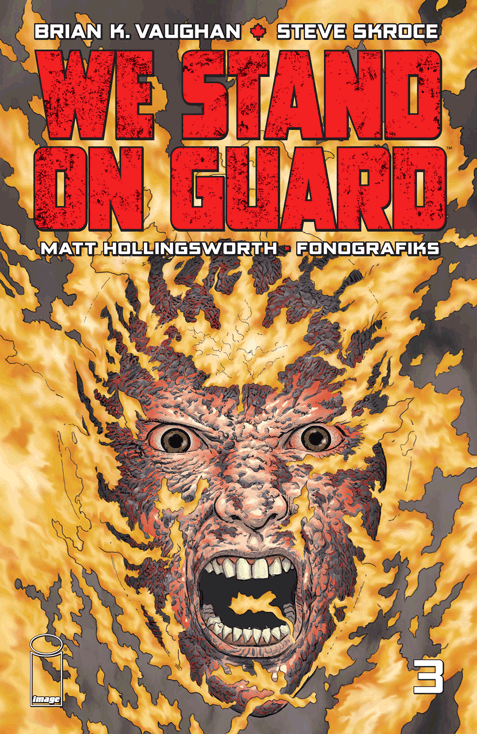Brian K. Vaughan and Steve Skroce continue to cultivate a haunting future amidst an otherwise beautiful setting in "We Stand On Guard" #3, where a group of Canadian freedom fighters take a stand against America's occupation of their country in the early 22nd century. In the aftermath of Vic's capture by American forces, the group rethinks their strategy even as Vic herself endures unthinkable torture during an interrogation about her group's whereabouts. Vaughan and Skroce's story is horrific in both obvious and subtle ways, using the story's setting as a means to enhance the disturbing elements of the story and implement intimidating visuals and psychological subtext, both of which make the issue an uncomfortable yet compelling experience.
Skroce warns readers of the ferocity of the story inside through the issue's cover, which graphically shows Vic's burning visage, symbolically punctuated with a flaming maple leaf on her forehead. The story reveals, though, that the cover is far from symbolic, and the potential misinterpretation works in favor of Vaughan's story when it delivers an eerily similar scene later in the issue. Even if the cover is seen as a giveaway, Vaughan works in a twist that puts this discomforting sequence in a whole new light; the technological advancements over the course of the past century have been shown to some degree in the past two issues, but this one reveals that these advancements also apply to so-called enhanced interrogation techniques.
Skroce also illustrates plenty of incredibly intimidating military weaponry, imposing through both their sheer size as well as their designs, which are natural looking extrapolations of existing tech. Skroce adds just enough of a tweak to give the U.S. military machine a look that's both impressive and definitively frightening. Further exemplifying this is the serene Canadian wilderness, looking as beautiful and timeless as ever, gorgeously rendered with panoramic-like magnificence by Skroce and colorist Matt Hollingsworth, yet also corrupted by the deadly high tech artillery that treads upon it. Other touches -- like the once-proud red maple leaf emblazoned on the front of a futuristic locomotive with the American flag plastered over it -- add to the troubling atmosphere and also convey the state of affairs in a nation under duress.
Vaughan carefully balances the story's advancement with the gradual rollout of past events, as seen through Vic's eyes when she was a child; through her, Vaughan reveals key elements about the overall nature of the U.S. invasion of Canada. Behind this, though, Vaughan also leaves vague notions that there is more to this history than what is being unfolded; there's a palpable sense of hidden agendas and untold secrets that Vaughan doesn't explicitly mention, but is nonetheless suggested by his script. His account of past events is scary yet fascinating and rooted in a past that seems all too real and not completely beyond the realm of possibility. As if to ensure that Vaughan is making his point, Skroce adds more remarkably simple but highly effective touches, like a map that shows the true extent of the American occupation.
"We Stand On Guard" #3 excels because it's disquieting, yet utterly addictive. Vaughan and Skroce successfully take elements from today's headlines and, with the slightest of nudges, turn them into something decidedly threatening, surprisingly believable and tremendously engaging.

